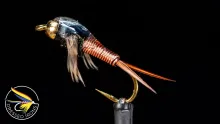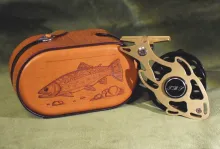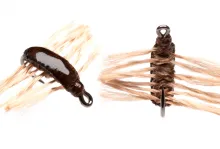I don't expect much from a rod drying motor. It should turn smoothly and hold a rod section securely while it turns. Bumps and wobbles and starts and stops are most unwelcome. Sections that come loose and stop turning are definite no-nos. An on-off switch is nice
Sully's 2-Speed Rod Drying Motor
GFF Rating: 3
It has all the bells and whistles, but given the asking price I expected a bit more reliability as far as the basic function of turning a rod while it is drying.

The Sully rod drying motor comes with all the basic essentials and is obviously sturdy and well built.
I don't expect much from a rod drying motor. It should turn smoothly and hold a rod section securely while it turns. Bumps and wobbles and starts and stops are most unwelcome. Sections that come loose and stop turning are definite no-nos. An on-off switch is nice.
With those thoughts in mind, I set out to buy a new drying motor last year to replace my older one that I was never quite happy with. I'm not the handiest guy in the world (and some would argue that I should probably buy rods off the shelf instead of building my own), so I looked around for a "complete" rod drying motor. By complete I mean one with a high quality chuck, a good motor, a rod stand, and solid construction. One that had all the bells and whistles and worked right out of the box without any tinkering required. The Sully motor seemed like the best one available. It also happened to be the highest priced.

A system of pulleys is used to vary the turning speed.
One aspect of the Sully motor that intrigued me was the fact that the chuck was not directly attached to the motor shaft, but rather via a system of pulleys. This allows the chuck (and thus the rod section) to turn at three distinct speeds, ranging from 4rpms to 22rpms, the theory being that the faster speed is good for applying epoxy to the thread wraps and the slower speed is good for drying. My old motor was 33rpms and used to rattle and bounce all over the place. I blamed the speed and the bouncing for some poor finishes I had produced. The Sully motor certainly turns smoothly and does not bounce at all, and since I can now adjust the speed of the rotating rod to a very slow rpm, I have removed those excuses. As it turns out, I don't use the slowest RPM setting much anymore. The finish I am using is quite thin and I feel a slow rotational speed will accentuate the "drip" affect as the epoxy cures, leading to rounded football shaped wraps. This of course is no reflection on Sully's motor, just my choice of epoxy and my finishing technique. As far as motor speeds, the Sully does what it says it does and does it well. Changing the speed is as simple as moving the band between the pulleys from one pulley to another. The chuck turns smoothly and evenly with no noticeble wobble or bounce.
Easily the most disappointing aspect of Sully's motor is the chuck. I've found it to fail it's most basic task - to hold the rod section securely in place while it is turning. More than once a rod section has slipped from the chuck when I've had wet epoxy on the wraps. Since I usually leave my rods to rotate and dry overnight, this could be a problem. It doesn't seem to matter if it's the butt section or the tip. Both can work loose within the first hour of turning.

Note the use of masking tape to help keep the tip section in pace as the rod is turning.
The butt section is held in place by simply inserting the reel seat into the chuck. All of the reel seats I have used feel snug when inserted, but invariably they work loose as the rod is turning. The tip section is held via tapered length of wood with a base that fits into the chuck. The female ferrule slides up this cone-shaped piece and is supposed to stay secure while it turns. It does not. I have solved both problems with liberal use of masking tape. I just wrap tape over the chuck and the reel seat when I work on the butt section and this will stay in place securely as the rod turns. Fixing the tip section problem was more difficult, and I'm
still not sure I have it completely solved, but what I've done works most of the time. I spiral wrap a piece of 1/4 inch masking tape along the length of the shaft of the "ferrule adapter" and twist the tip section onto the shaft as tightly as I dare. This usually holds, 'cause the edges of the tape help keep the female ferrule secured to the adapter. I'll sometimes reverse the tape and have a portion sticky side up from the tip of the adapter which further holds the blank in place.
If this motor had a better chuck system that worked equally well for butt and tip sections,
it would clearly deserve a very high recommendation. To be honest, given it's asking price, I am disappointed in the performance of the chuck. Although common sense should have me taking the precautions with masking
tape when securing blank sections, I shouldn't be forced to do so because of the shortcomings of the chuck design. It doesn't perform it's basic function of reliably holding the rod securely in place as it rotates.
Still, the shortcomings are easily cured and I am confident I will build many rods on this motor without any future problems.
Availability, October 2014
This specific rod dryer can be hard to find, but a two-rod version is widely available.
You can get the double version of this dryer from Mudhole, who has very large selection of rod building stuff. The price is about US$ 90.- at this time.
- Log in to post comments








where can I get this
where can I get this Sully's 2-Speed Rod Drying Motor
and how much is it?
Thanx for this info,
Thanx for this info, A. Ames. The o-ring drive belt on my Sully "dually" broke today and I had no idea how to replace it. The specs you provided are extra helpful. Now all I need is an ancient hardware store, or maybe a hydraulic cylinder overhaul shop with a huge selection of o-rings.
I just "fixed" a Sul
I just "fixed" a Sully Rod Dryer, it's set up to dry 2 rods at a time. All it took was 2 - 2 3/16 X 3/32 O-Rings that I bought from the Local Hardware Store. By Local Hardware Store, I'm talking about one of those disappearing relics owned by a very old man. he's 82 or so. It's one of those great hardware stores where you can find everything and anything, and it's about 10 miles closer than any "Big Box" company, and many times, it's cheaper. I digress.
What a cheap fix!
Each O-Ring was 60 Cents, so for $1.20 I got this thing up and running again.
This item will be for sale on e-Bay this week, if your interested. 7-19-2012
I've had a sully's f
I've had a sully's for over 10 yrs. The belts are cracking - need some new ones. Help me if you can. Go to a trophy shop and ask for half inch double sided tape. I dried over 30 fly rods on about 12" of this stuff. a 60 yrd roll will last a life time.
This may be a long s
This may be a long shot but I am looking to buy another Sully's rod finisher. I bought one 3 years ago when I helped a Varsity Scout troop learn how to make their own custom fly rods. Before our 5 day pack/fishing trip through the Uintah's I loaned it out to one of the boys who was late getting his finished and never got it back. Sadly I think it's history. Can anyone direct me to where I can get another one? The one I had before had two rubber reel seat holders instead of just one like the photos show. I would like another double one if possible. My son wants to make his own rod now - I couldn't be more excited. Please help me :) Thanks
the information on t
the information on this page is very informative to me as a beginer at trying to make a fishing rod for myself thank you very much